"One really interesting use of a Class 60 that encapsulated the transience of EWS cascading, was the Lickey banking duty."

60076 in the EWS-branded version of BR's triple-grey livery, with a Round Oak - Margam run on 6th June 2007.
They still felt new. It just wasn't what we were expecting to happen...
If any locomotive type seemed safe from the effects of post-BR renewal, it was the Class 60. Reassuringly bulky, with monster tractive effort, the Brush/Mirrlees Type 5s were a product of the late 1980s, starting service in the early 1990s, and the last of them had not been ready to run until 1993. Just three years later, the locomotive order which would rapidly end their reign of UK freight supremacy was signed and sealed.
That was the pioneering EWS Class 66 order. And initially, that's all we thought it would do. Dislodge the Class 60 from its perch as the premier UK freight loco. But the Class 66 was a lot tougher on the Brush/Mirrlees behemoth than that. It usurped the mighty 60s just as it had usurped every other main line freight diesel in the EWS fleet. By the late 2000s, the number of Class 60s in service would be down from the original total of 100, into single digits.
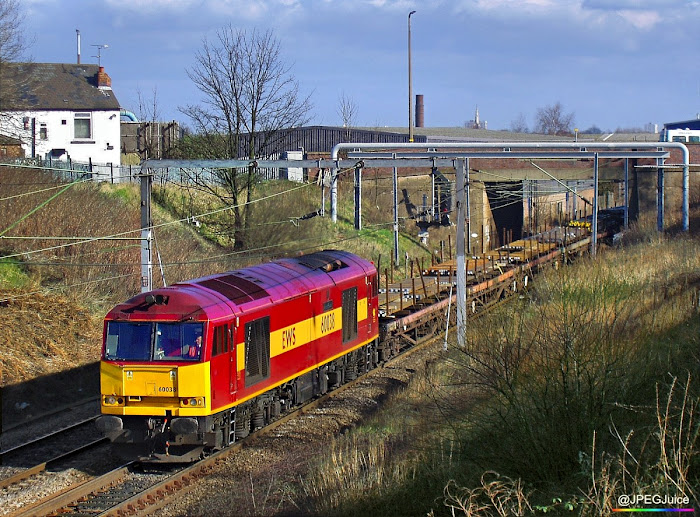
Some steel trains to Wolverhampton were scheduled for Class 60 haulage. Here on 23rd February 2004, the Class 56-hauled Aldwarke - Wolves has literally run out of 'Grids' due to withdrawals. Although the train was transitioning to Class 66 power, EWS red 60038 charitably made itself available for the duty on this occasion.
What we hadn't reckoned on, was EWS losing its near monopoly in UK mainland railfreight, along with the loss of major contract work such as mail by rail, and the underestimated knock-on effects of widespread diesel locomotive passenger haulage coming to an end between 1999 and 2002. EWS had a much bigger finger in that passenger haulage pie than our fading memories perhaps recall today.
In the 1990s, EWS inherited virtually all UK freight bar Freightliner's intermodal traffic, and was increasing its workload. It also inherited all of the British Rail stock that went with the work - including the entire, 100-strong Class 60 fleet. Despite EWS being rather sceptical of ex-BR locos in general, there appeared to be no threat at all to Loughborough's finest.
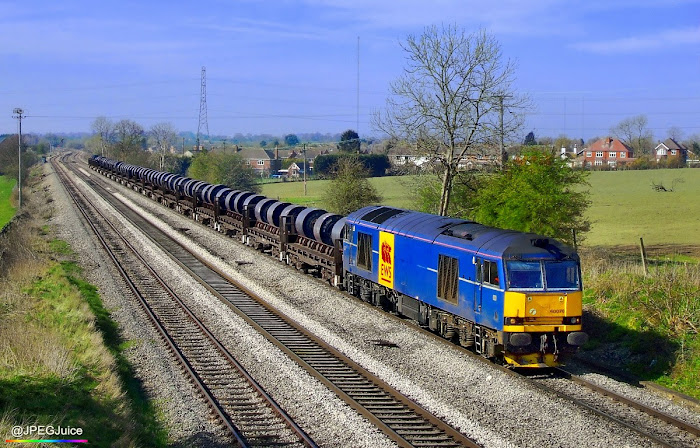
EWS branding began to appear on Class 60s with older BR liveries from 2005. This is Mainline blue 60078 on the Margam to Corby loaded steel of 5th April 2007.
But in the 2000s, things went the other way. Royal Mail dumped rail transit, rendering a stable of mostly new EWS locos spare. Freightliner began to diversify and upscale on EWS territory, as DRS entered new markets, and the likes of GBRf began growing from the ground up. Smaller independents also entered the arena, including Cotswold Rail and Fastline, and later Advenza and Colas Rail - although the latter two didn't spring into view until after EWS had become DB Schenker. And the loco hire business impacted EWS too. Although Fragonset was targeted at passenger operators, it did also extend to non-passenger duties, and as it expanded, it cut down on the demand for EWS cover on passenger trains.

Coal was a traditional Class 60 application, but after the Class 66s arrived, EWS Class 60s lost most of the work and could generally only deputise for their newer counterparts in the early 2000s.
The picture for the EWS Class 60 was one of progressive cascade. The 60s lost coal duties and a range of tank trains directly to the Class 66s, and started to move onto services that had previously employed older BR diesels. In some cases, the arrival of the 66s simply allowed the 60s to work their booked trains. In 1997 and much of 1998, this had not always been possible, and the problem actually became a celebrated realm of enthusiast entertainment as trains like the Notholt - Calvert 'Binliner' produced a range of old gems in place of the allotted Brush 5.

60100 has command of the 08:57 Cliffe Vale - St Blazey empties, at Aston Fields, Bromsgrove, on 23rd August 2000. This train was technically an Enterprise run forward from Bescot, where the load behind the slurry tanks would have been added.
The St Blazey - Cliffe Vale china clay also began to employ Class 60s long before the first 'Shed' hit the dockside. But again, availability was an issue, and the service pretty much gave up its quest to procure a Type 5, slipping back into a regular pattern of double-headed 37s for 1998 and the first half of 1999. It was summer '99 before the new GMs had freed up enough resources for a reliable switch from twin 'Syphons' to a single 60. But the Brush/Mirrlees residency only lasted until early 2002. I began to note regular Class 66 haulage on the china clay from March that year. That's how transient the cascading could be. One minute the trains couldn't get a 60 for love nor money. The next, they no longer wanted a 60.

The Cliffe Vale - St Blazey run was also used to transport Type 3s to Cornwall for local work. here on 30th May 2000, 60049 powers the train into the loop at Bromsgrove, with 37174 enjoying a free ride to the West Country.
Early in their lives, the Class 60s had worked coal, steel and tank trains - notably, for West Midlands enthusiasts, some of the tank trains out of Bromsgrove Oil Terminal, which had formerly been entrusted to double-headed 37s. But the cascade started by the Class 66s in 1998 decanted the 60s into the following scenario...
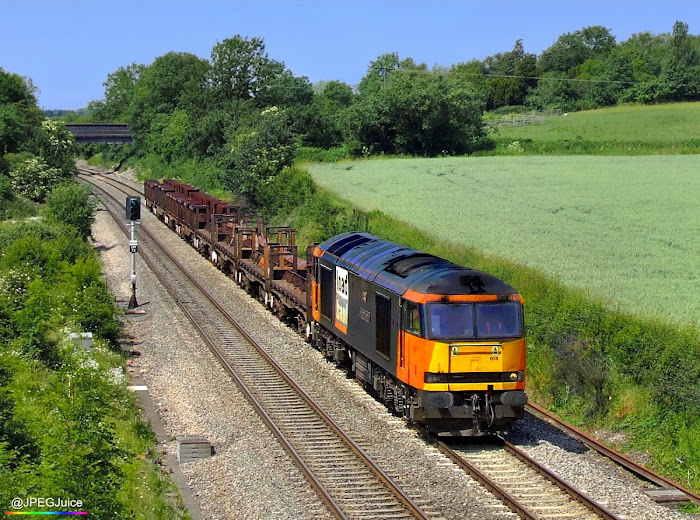
Loadhaul livery remained extant on the Class 60 throughout the tenure of EWS.
NOTABLE SCHEDULED CLASS 60 WORKINGS IN THE WEST MIDLANDS - CIRCA 2000
The trains listed below would normally have other legs to their diagrams. I've only included the most commonly noted leg. Not all trains would run daily.
All Lickey banking duties.
08:29 Lindsey - Kingsbury (tanks).
08:48 Lackenby - Wolverhampton Steel Terminal (steel).
08:53 Cardiff Tidal - Ironbridge Power Station (tanks).
08:57 Cliffe Vale - St Blazey (china clay empties / Enterprise).
09:30 Stud Farm - Bescot (ballast).
09:57 Round Oak - Margam (steel empties).
10:03 Kingsbury - Humber (tanks).
10:56 Rectory Junction - Robeston (tanks).
13:45 Saltley - Cardiff Tidal (scrap metal).
13:53 Handsworth - Cardiff Tidal (scrap metal).
13:59 Peak Forest - Washwood Heath (hoppers).
17:50 Margam - Wolverhampton Steel Terminal (steel).
18:00 Rugeley - Bescot (ballast empties).
18:40 Kingsbury - Cardiff Tidal (scrap metal).
22:02 Roundwood - Wolverhampton Steel Terminal (steel).
Whilst trains such as the 15:40 Bescot - Round Oak Enterprise and the 10:16 Toton - Round Oak steel were not booked for a 60 in 2000, for at least some of the year they frequently produced one. Note that even as early as this there is no longer any booked coal for Class 60s through the West Midlands. The type did, however, stand in for 66s on coal traffic as and when required.
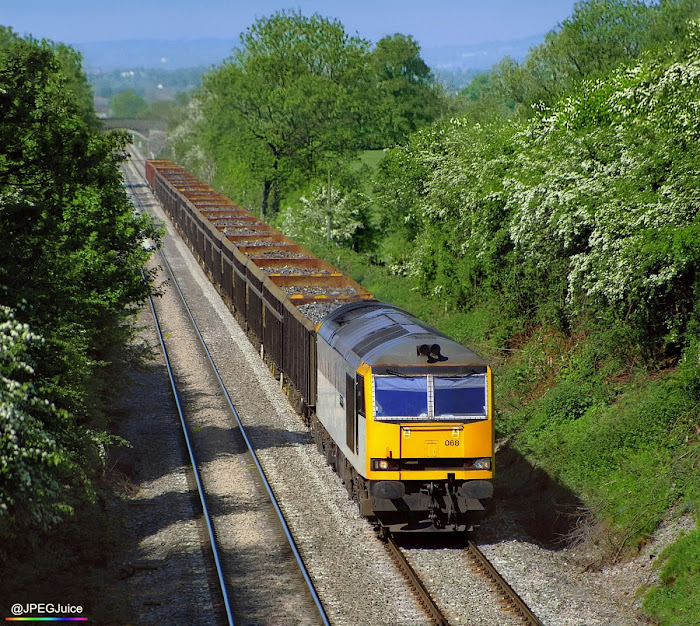
The afternoon Saltley to Cardiff Tidal scrap metal was a reliable EWS Class 60 turn in the late 1990s and through to 2003. It then began to waver onto GM power and was a pretty solid EWS 66 turn running from Beeston to Cardiff by the middle of the decade. I last recorded an isolated Class 60 appearance on it - triple grey 60028 - in May 2006, and shortly after that, Freightliner took it over, employing 66s. EWS actually got it back in 2007 (still using 'Sheds'), but in the first half of 2008 the path was won by Advenza Freight, who ran a Stockton to Cardiff scrap train in its place - booked for a 57. Above, you're seeing an archetypal 2000 scene at Shernal Green, with 60068 on the Sunday service, 14th May.
NOTABLE SCHEDULED CLASS 60 WORKINGS IN THE WEST MIDLANDS - CIRCA 2005
Five years later the picture had evolved significantly. Again, best known leg of the diagram only, and a lot of these were not daily workings - some ran one day a week only...
07:18 Wolverhampton Steel Terminal - Doncaster (steel empties).
10:10 Corby - Margam (steel empties).
11:18 Westerleigh - Humber / Port Clarence (tanks).
12:45 Walsall - Tunstead (cement tanks).
12:48 Washwood Heath - Peak Forest (hoppers).
13:31 Didcot Power Station - Lindsey (tanks).
16:23 Immingham - Wolverhampton Steel Terminal (steel).
16:45 Trostre - Doncaster (Enterprise).
16:58 Bedworth - Lindsey (tanks).
17:25 Llanwern - Lackenby (steel empties).
17:38 Margam - Hartlepool (steel).
18:04 Immingham - Margam (Enterprise).
18:39 Tees Yard - Margam (steel empties).
18:47 Westerleigh - Lindsey (tanks).
20:36 Tees Yard - Newport docks (aluminium).

Trains in and out of Round Oak varied in their booked traction, and were mainly booked for 66s in both 2000 and 2005. However, they were often very long trains ideally requiring the tractive effort of a Class 60. This is the 15:07 Llanwern - Round Oak in the care of Transrail grey 60061 at Littleworth, on 13th July 2006.
Although the 2005 list doesn't look much shorter than the 2000 list, the prevalence of the 60s had declined, and they were much less likely to dep for 66s than in 2000. Up until 2002, the 60s appeared regularly on coal trains despite not being booked traction. But this was very rare bordering on non-existent by 2005.
LICKEY BANKING
One really interesting use of a Class 60 that encapsulated the transience of EWS cascading, was the Lickey banking duty. The banker(s) had still been alternating between two Class 37s and a single Class 58 in autumn 1999. But just before the end of the century, banking switched wholesale to a single Class 60. In 2000, 2001 and 2002, the banker was very reliably a 60. But the 60s were themselves replaced in 2003, by Class 66s.
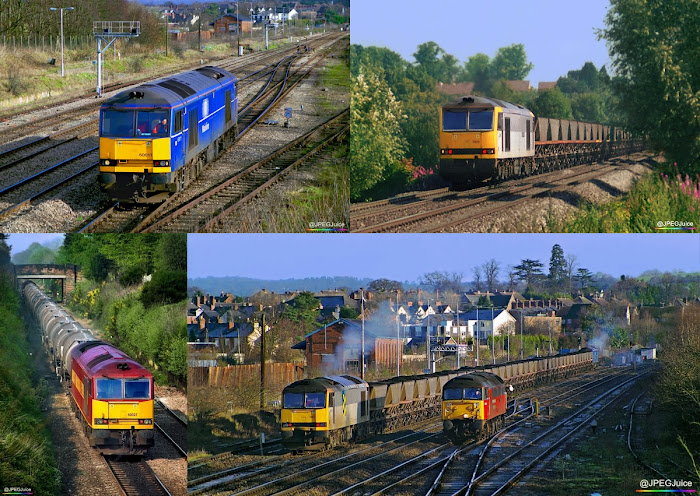
The compilation above shows: Mainline blue 60011 - Lickey Banker 28th February 2002. Unbranded grey 60068 - Lickey banker 24th August 2000. EWS red 60027 - Lickey banker 6th May 2000. Trainload grey 60031 - Lickey banker 14th February 2002.
Unlike the Class 66 bankers, which from the start were restricted to a handful of specifically compatible locos, any available 60 could work the bank. Before spring 2000 there were no daytime banking duties at all, and once daytime banking did restart, instances were kept to a minimum. Nevertheless, the short period in which EWS 60s banked loaded coal, tanks and heavy steel on the 1 in 37 evokes fond memories.
The revival for daytime banking began in April 2000, when 60041 was dispatched from Saltley to bank the virtually brand new 66203 on the 08:45 Burngullow - Warrington 'Silver Bullet' tanks. The 'Bullet' was itself a former Class 60 duty which had been taken over by 66s. The train normally went via the Severn Tunnel, but was diverted for several weeks due to track renewal.

The photo above was taken on 29th April 2000 - the fifth week of the diversion. It shows 60041 - coincidentally the same banker that was sent on week one - making for the rear of the 'Bullet', this time hauled by 66092. The pair of DRS 20s parked in the sidings on the distant left had brought a departmental train down from Crewe Basford Hall. The duo - 20309 and 20315 - continued to Berkeley the next day. The bottom left shot in the previous compilation shows 60027 banking the Burngullow - Warrington the following week.

After dispatch from Saltley, the banker was stored south of 'Bankers Bridge' in the northbound siding alongside the Bromsgrove Automotive factory (demolished 2003). In the shot above, I'm in the field on the east side of the line, looking west towards Bromsgrove Automotive. The driver is looking out of the northbound cab window anticipating the arrival of the Avonmouth - Ironbridge coal, and the loco is ready to draw forward and bank. I took the shot on 22nd September 2000. 60040 was an early EWS repaint, and sported the original livery with "EW&S" branding and no cabside emblem. It retained this look until 2008, when it received a one-off DB Schenker livery.
LIVERY QUIRKS
You can find a full explanation and depiction of the standard liveries worn by Class 60s in this period, along with a late 1990s livery snapshot list of the entire fleet, in the Tug Aesthetica post. But here are some of the special liveries of the time...

60006 in British Steel blue.
60006 and 60033 were selected for a special light blue British Steel livery in summer 1997, and repainted that July. 60006 Scunthorpe Ironmaster was notably a special guest at the Toton open weekend of late August 1998, whilst in British Steel blue. Sadly, it later achieved a very different kind of notoriety when it became the first Class 60 to face the cutter's torch. Although both locos were idealistically doyens of the North East in their British Steel blue days, they could end up anywhere - including Cornwall.

60033 in the later Corus Silver.
60006 and 60033 retained their British Steel blue livery until November and December 2000 respectively, at which point they were outshopped in a rather less eyecatching silver Corus livery. It was an attractive aesthetic in itself when freshly painted, but it wasn't different enough from the look of some of the faded triple-grey 60s to really stand out. And arguably, the original triple-grey was a more considered livery design.
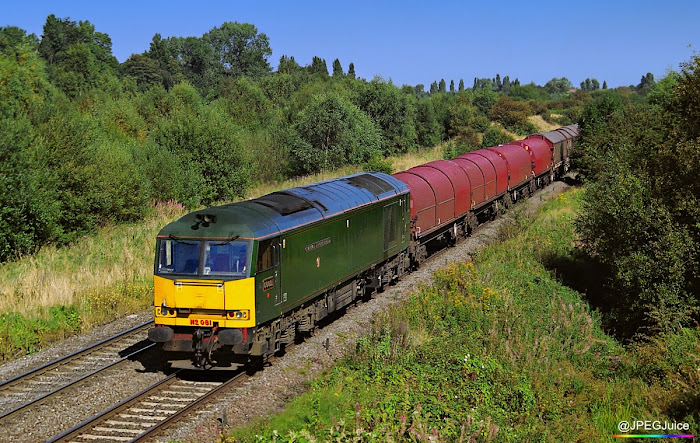
60081 in GWR green.
On 25th July 2000, triple-grey 60081 - formerly Bleaklow Hill - was admitted to the paint shop at EWS Toton for a makeover which would see it become a celebrity. The repaint into GWR green, accompanied by the fitting of Isambard Kingdom Brunel nameplates, made the loco a leading attraction at the Old Oak Common open weekend of 5th and 6th August Y2K.
IN PICTURES

The Saltley to Cardiff scrap would begin its journey heading north as far as Bromford Bridge, where the loco would run round. Above, on Sunday 24th June 2001, 60098 was allocated to the working, and was caught at Bromford waiting for a restart path as 47786 took priority on a diverted Euston - Wolves drag. On a Sunday, the run-round layover here would be relatively short, but in the week the scrap could be stuck here for a very long time. The weekday run left Saltley at 13:45, but didn't normally reach the Lickey Incline until around 17:00.
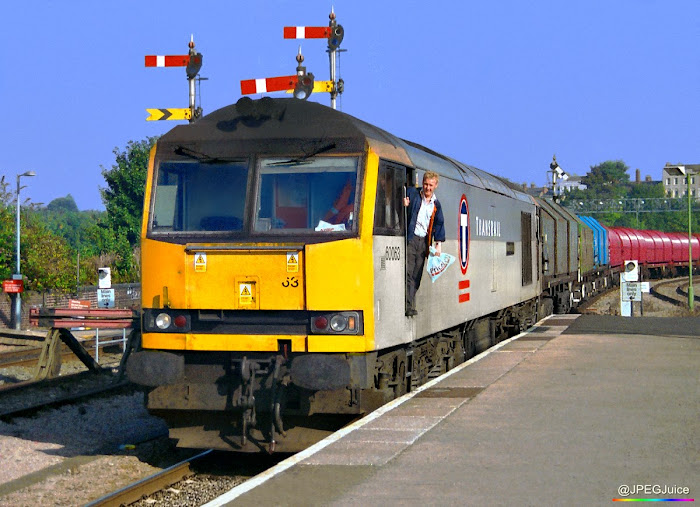
The 10:16 Round Oak - Margam was a booked Class 60 turn in 1999, and is seen above in the hands of 60063, at Worcester Shrub Hill on Saturday 4th September that year. The train almost always ran about two hours early. It was down as a 66 working by 2000, but did still get a 60 from time to time.
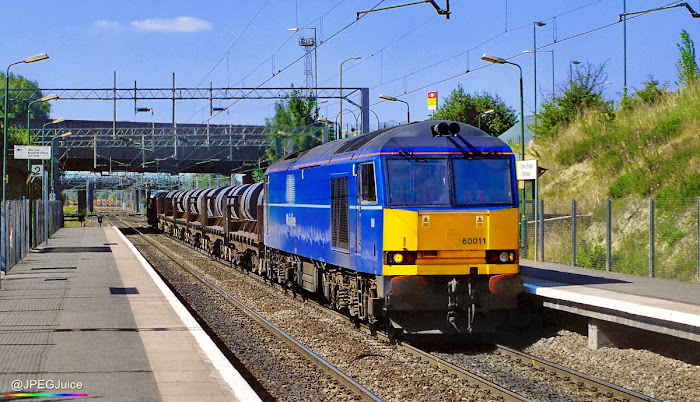
Another from the 1990s. Before the Class 66s took it over, the 15:44 Bescot to Round Oak Enterprise employed a variety of loco types. Although it was officially booked for a 58, here's the train with a steel coil load, accelerating through Tame Bridge Parkway courtesy of Mainline blue 60011.

One of many trains that would eventually shift from Class 60 to Class 66 power under EWS was the Lackenby to Llanwern steel. This shot shows 60055 hauling the train on 29th July 2001. Note where this loco has its orange warning band - immediately above the cab windows like an EWS red or Mainline blue example. The default for triple grey was a step higher between what should be the mid grey roof and the black cab top. The band was technically better placed where it appears here on 60055, but to fans of the 60s in triple grey livery it just didn't look right.
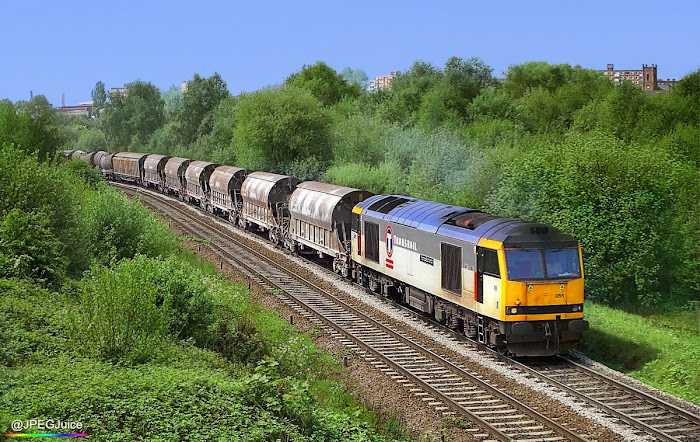
And 60055 was actually the loco that, in this Transrail livery, took part in the press photocall at Marylebone on 24th February 1996, marking Wisconsin Central's absorption of three British Rail freight businesses for what would become EWS. Loadhaul 56102 and Mainline blue 58050 joined the grey 60 at the event. Above, 60055 is allocated to the 08:57 Cliffe Vale - St Blazey china clay empties, near Walsall, on 15th May 2000.
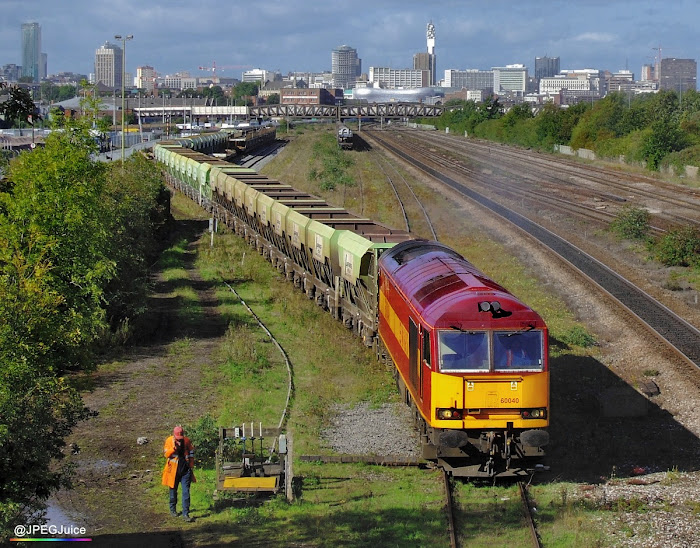
Self-discharge trains were Class 60 turns in the 1990s before the Class 66 invasion. I noted Class 66s on them forward from spring 1999, but once again, they were often very long trains, and since the 60s remained in some ways preferable for lengthy, heavy traffic, they could turn up on self-discharge right up to the twilight of EWS. Above, we're at Small Heath overlooking 60040 and its Lafarge hoppers in Bordesley Yard in October 2006.
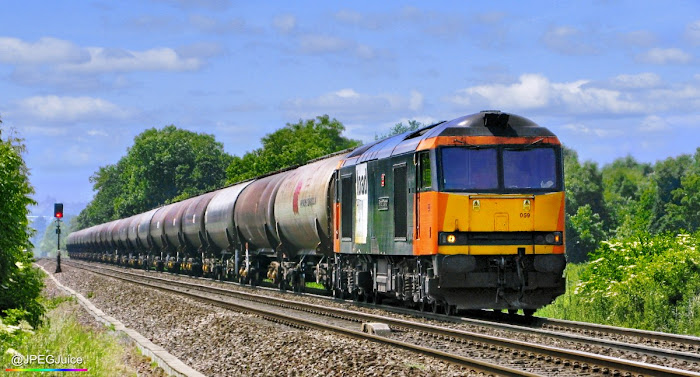
Tank trains in and out of Westerleigh became the last bastion of West Midlands Class 60 action in the 2000s, and became very popular with lineside enthusiasts due to their unassisted ascents of the Lickey Incline. Above you're seeing Loadhaul liveried 60059 in action on the celebrated Westerleigh - Lindsey, at Vigo, about a quarter of the way down the Lickey.

Whilst 60059 retained its Loadhaul branding even well into the DB Schenker era, 60007 had its surviving Loadhaul livery augmented with the large, yellow, bodyside EWS stick-on. Here's the loco at Tame Bridge Parkway on 11th May 2006.

If the survival of Loadhaul livery beyond the EWS era was remarkable, the survival of original Trainload liveries was more remarkable still. Trainload grey was the first livery carried by the Class 60s, and one might have expected it to vanish in the mid 1990s with the simple removal of Trainload decals and replacement with either Transrail, Loadhaul or Mainline branding. Not only did it survive that phase - it also survived the admittedly lax EWS repainting programme for over a decade, and managed to reach the 2010s under DB Schenker. The photo above shows 60060 in its original Trainload Coal livery on 20th February 2004, at Stoke Prior, on loaded steel.
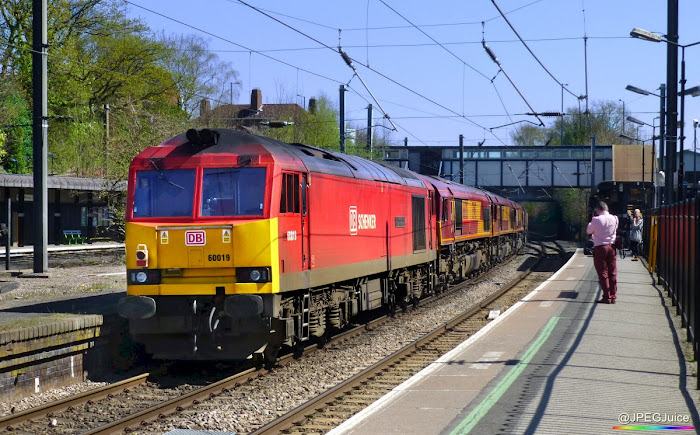
60019 in DB Schenker livery in a convoy with 66135, 66041, 66085 and 66204, at Kings Norton, in 2015.
Thanks to the 'Super Sixty' overhaul and interest in the class from other freight operators, there's been a measured renaissance for the Brush/Mirrlees behemoth since its operative low point in the late 2000s. But to imagine that BR's final freight diesel has anything like the realm of activity today that it had in the 1990s would be fantasy. The Class 60 had a short heyday, and never recovered from the superior economy of the Class 66.
If you've enjoyed this post, don't miss Tug Aesthetica: Making Sense of the Class 60's Earlier Visual History.